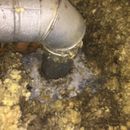Methods for keeping cellulose insulation from gas flue line
Hi,
I am preparing for an attic project: air sealing, and blowing in new insulation.
We have a gas furnace, and its exhaust flows in a Type B vent pipe through the attic and out the roof. The Type B requires 1″ clearance to combustibles.
There is already metal around the vent pipe where it enters the attic (picture should be attached). There is some gap between the vent and the metal, which I plan to seal using high temperature caulk.
There is currently nothing to separate the vent pipe from the attic insulation. I’m having a contractor blow in cellulose insulation, so I want to make sure we have that 1″ clearance away from the cellulose. The energystar website suggests making a sort of dam using aluminum flashing. On the other hand, the contractor says they typically wrap the vent pipe with rockwool insulation, in order to create that clearance. Does anybody have experience with either method? Is the rockwool idea safe? What is the best way to maintain the 1″ clearance?
I don’t know the efficiency of the furnace (predates our ownership of the house), and I don’t know how hot those gases are, coming out of the furnace.
GBA Detail Library
A collection of one thousand construction details organized by climate and house part










Replies
Sam,
On any code question, it's always a good idea to contact your local building department to get a local interpretation of the code.
Here's my understanding:
1. B-vent is double-walled metal pipe. If you are penetrating an insulated assembly (like a ceiling), you can't penetrate the assembly with single-walled pipe. So I'm assuming that you have B-vent (rather than single-walled stovepipe) penetrating the ceiling.
2. You have to maintain the one inch airspace where the B-vent penetrates the framing. It sounds like you've done that.
3. Once you are in the attic, past the framing and the air barrier -- the air barrier is usually created with sheet metal sealed with high-temperature silicone caulk -- you don't have to continue to maintain the 1-inch air barrier, to the best of my knowledge. The usual method to ensure fire safety is to wrap the B-vent (from the air barrier to a point higher than the insulation depth) with a mineral wool batt, secured with steel wire. The mineral wool batt ensures that cellulose won't touch the B-vent. This method is described by Bill Hulstrunk in a GBA article, How to Install Cellulose Insulation.
Thanks. I'll see if the AHJ can give an interpretation. But it sounds like the contractor is planning to do something in line with common practice. So that's good.